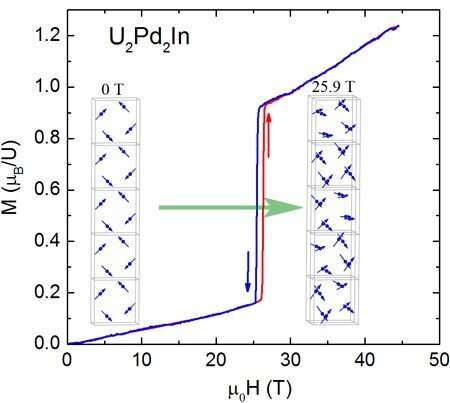Credit: HZB
High magnetic fields have a potential to modify the microscopic arrangement of magnetic moments because they overcome interactions existing in a zero field. Usually, high fields exceeding a certain critical value force the moments to align in the same direction as the field, leading to ferromagnetic arrangement. However, a recent study showed that this is not always the case. The experiments took place at the high-field magnet at HZB's neutron source BER II, which generates a constant magnetic field of up to 26 Tesla. This is about 500,000 times stronger than the Earth's magnetic field. Further experiments with pulsed magnetic fields up to 45 Tesla were performed at the Helmholtz-Zentrum Dresden-Rossendorf (HZDR).
The physicists examined crystals of U2Pd2In, which form a special class of solids (Shastry-Sutherland systems). The interactions between the magnetically active uranium atoms are quite complex in this structure, mainly due to the extended 5f orbitals of the outermost electrons of uranium in a solid. These 5f electrons are also carriers of the magnetic moment in the material.
Using neutron diffraction in strong fields they found an unusually complicated non-collinear modulated magnetic structure above a critical magnetic field. The magnetic unit cell is twenty times larger than the crystallographic unit, containing 80 magnetic moments. Such a structure is a consequence of competition between different strong interactions and the applied field. "Our results are important for two reasons," Dr. Karel Prokes (HZB) says. "First, they show that the field induced phase is not ferromagnetic and the magnetization increase at high fields is probably due to a gradual rotation of U moments towards the field direction, a finding that might be of relevance for many other systems; and second, they may help to develop more precise theories dealing with 5f electron systems."
More information: K. Prokeš et al, Noncollinear magnetic structure in U2Pd2In at high magnetic fields, Physical Review Research (2020). DOI: 10.1103/PhysRevResearch.2.013137
Provided by Helmholtz Association of German Research Centres
























